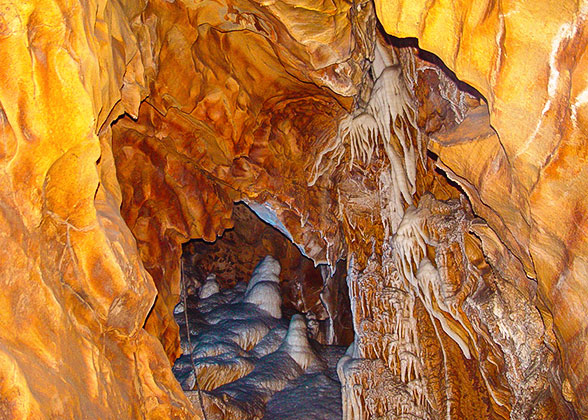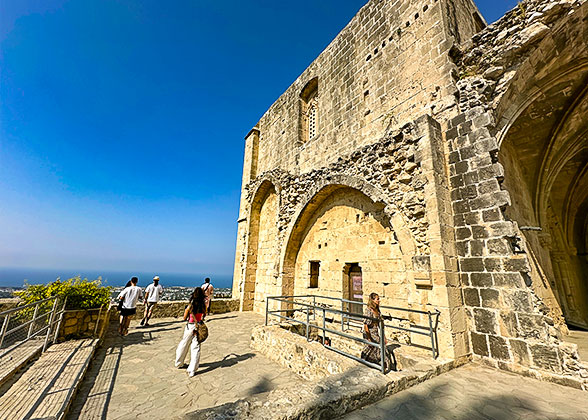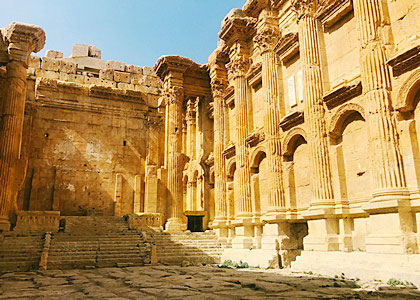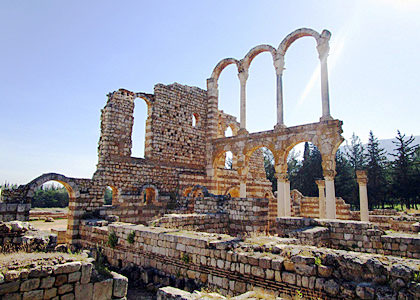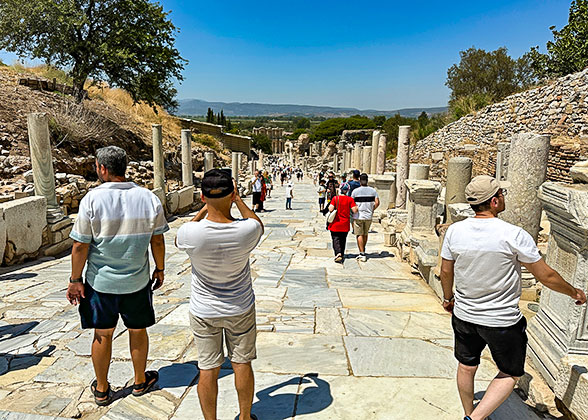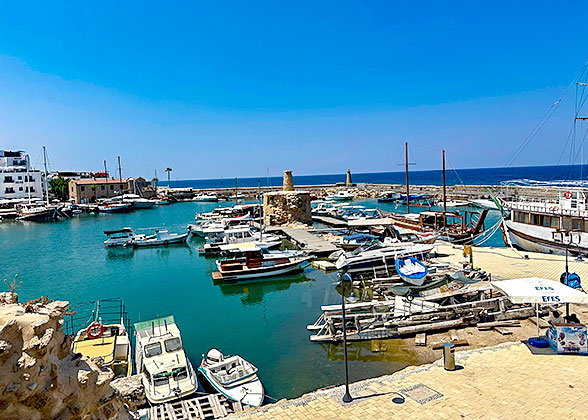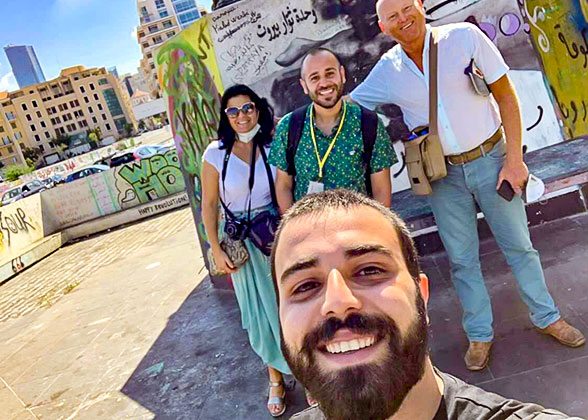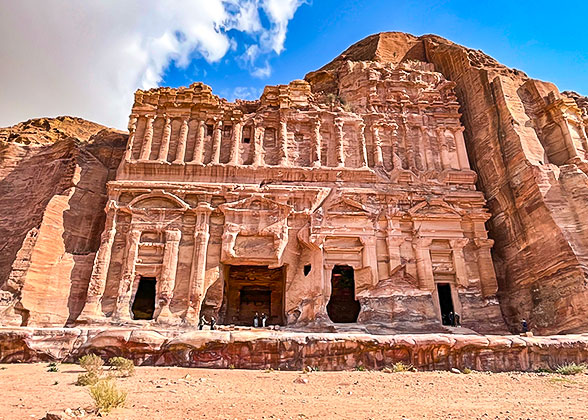Day 1: Arrival in Beirut, Lebanon; Airport Pick-up
Welcome to Lebanon! When your plane lands at the Beirut Rafic Hariri International Airport, you can go through the customs and immigration procedures first and then get to the Baggage Claim Hall. Our English-speaking driver will be waiting here with your name tag. Then he will arrange your private airport transfer to the hotel, which takes about 15 minutes on the way.
Activities & Dinner Suggestion:
We won’t have any sightseeing plan for the rest of the day, so you can relax in the hotel. Our hotel of choice is located in the heart of Beirut, so if you still feel energetic, you can get out and have a stroll. The hotel is within walking distance of both the busy Hamra Street and the quiet and beautiful seaside promenade. You can have dinner at the hotel restaurant or find a favorite restaurant on the nearby Hamra Street.
|
Day 2: Highlights of Capital Beirut
After breakfast, our guide and the driver will pick you up at your hotel and show you around downtown Beirut. We will visit the National Museum, Mohammad Al-Amin Mosque, Saint Georges Maronite Cathedral, Beirut Souks, Clock Tower, and American University of Lebanon.
► Mohammad Al-Amin Mosque: Blue Mosque of Lebanon
You may have heard of the Blue Mosque, the landmark of Istanbul of Turkey. In Lebanon, the Mohammad Al-Amin Mosque is called the ‘Blue Mosque’ likewise, as it has a similar style with blue domes. The difference is that the Blue Mosque in Turkey has six minarets, while the smaller one in Lebanon has four.
In addition, we will specially arrange a visit to the Beirut Green Line, which was the demarcation line between east and west Beirut during the Lebanon Civil War. It is both a witness to war and a memorial to peace. Finally, let’s go to the Corniche for the sunlit Pigeon Rocks, aka the Raouche Rocks, and the stunning seaside views during sunset.
Meals: Breakfast, Lunch
|
Day 3: Jeita Grotto, Harissa & Byblos
Today we are going to visit the natural wonder of Lebanon – Jeita Grotto. It is a karst cave with two levels. Our guide will lead you to see the upper cave on foot and then take a boat tour in the lower cave. Our next destination is the Our Lady of Lebanon – the Shrine of Virgin Mary in Harissa. ★ What makes us different: We will specially arrange for you to take the sightseeing cable car to the Our Lady of Lebanon on the mountain top. From the gondola, you can enjoy the panoramic view of the mountain village Harissa and the magnificent waterfront of the Jounieh Bay. Our Lady of Lebanon, a Magical Place of MiraclesIn Harissa, it’s believed that the Shrine of Our Lady of Lebanon has a magical power of the Virgin Mary, which makes miracles happen with blessings for people. A true story goes that a woman, who leaned against the railing to take pictures of Our Lady, slipped and was about to fall down. In a desperate moment, she was saved by a young man named Faidi. Faidi told her that his mother once suffered from infertility, but she became pregnant after praying to Our Lady devoutly for four days. From then on, every year on his birthday, his mother has brought Faidi here to worship Our Lady of Lebanon. As getting to the shrine, you may pray and try to feel the miraculous power. Lunch will be served at a local restaurant. After lunch, we will drive about 20 minutes to Byblos. Being a World Heritage site in Lebanon, Byblos is one of the oldest surviving cities in the world, dating back over 7,000 years. The guide will take you through the Saint John Church, Roman Amphitheatre, Byblos Citadel, and the Old Souks. After the visit, we will return to Beirut for the night. Meals: Breakfast, Lunch Jeita Grotto Byblos Castle
|
Day 4: Visit Ancient Batroun and Taste Local Beer
In the morning, drive about an hour north to Batroun, an old and charming seaside town. Here, our guide will lead you to start a 2-hour walking tour of Batroun, visiting the traditional Ottoman houses, the ancient Phoenician Wall, Batroun Old Souk, Church of Our Lady of the Sea, and the fisherman port. On the way, the guide will invite you to taste the authentic Batroun-style fresh lemonade. Lunch will be served at a decent local sea food restaurant.
★ Beer Tasting: After lunch, we will arrange a special stop for you, the Colonel Brewery And Distillery, where you can not only learn about the unique local brewing process, but also taste many different beers. Enjoying a beer with a view of the sea in a cool room or outdoor seating would spice up your stay in Lebanon. After a relaxing afternoon, we’ll head back to Beirut.
Meals: Breakfast, Lunch
|
Day 5: Cedars of God Forest, Gibran Museum & St. Anthony Monastery
In the morning, we will drive 2 hours to Becharre (Bsharri). The guide will take you through the ancient Forest of Cedars of God, where each tree around you is at least 1,000 years old. Then we will visit the Kahlil Gibran Museum. Once an ancient cave where many monks sought refuge, it had later became the tomb and a small museum dedicated to Kahlil Gibran, the Lebanese-American poet and painter.
“We already walked too far, down to we had forgotten why embarked.”
You may be familiar with the famous saying. It is from The Prophet, a renowned book by Kahlil Gibran. He was born in 1883 in the hill town of Becharre, where his home was converted into the Kahlil Gibran Museum. With the guide, you can slow down to see the artistic works and manuscripts by this litterateur, look back the way you come, and think what your original intention for embarkation was in the peaceful and picturesque house.
We will conclude today with a visit to the St. Anthony Qozhaya Monastery, which dates back to the 12th century and is still the holy place for the local hermits and pilgrims.
★ Unique Accommodation Experience: At the St. Anthony Qozhaya Monastery, there is a simply-furnished guesthouse where we will arrange for you to stay for one night. The guesthouse is well designed and decorated, with beautiful stonework, carved wooden doors, and traditional stained glass lanterns. Aside from hikers in the Kadisha Valley, most of the guests are pilgrims and church groups. You’ll have a good sleep here because it is very quiet at night.
Meals: Breakfast, Lunch
|
Day 6: Join Morning Prayers & Hike Kadisha Valley
With the sound of the monastery’s bell, please get up early, therefore you can join the monks’ morning prayer inside the monastery. Please note that the Catholic service is conducted in Arabic.
★ Kadisha Valley Hiking: Touch the Reclusive Life of Monks
Kadisha Valley, aka Holy Valley, is home to many earliest monasteries; thus, it has been listed as a world heritage site. It possesses various naturally formed caves, which became shelters of Paleolithic cavemen. During a few centuries after the advent of Jesus, more and more Christians hided in the valley to escape from persecutions by Romans and Arabs. Countless caves, monasteries and churches were built in Kadisha Valley, where monks and nuns still live in today.
After breakfast, we will drive about 10 minutes to Hawqa Village, where today's guided hike will start. Follow the guide to go through a rocky path all the way down to the bottom of the valley. There you will visit the Monastery Saydet Hawqa, Chapel of Mar Marina, and finally the Dier Qannoubine Monastery. Let’s learn the miserable history long before, and witness the reclusion of monks. Their days look good, filled with praying, gardening, cooking and having meals, and of course, meeting guests.
The hike will take about 2 hours. For lunch, we will arrange a special Lebanese meal at a local restaurant for you to enjoy the Lebanese mezze, mixed grill, arak, and soft drinks. After lunch, continue hiking for one hour. The guide will take you deep into the valley along the LMT trail until you reach a small village of Fraidis. After the hiking, the guide and the driver will escort you back to Beirut.
Meals: Breakfast, Lunch
|
Day 7: Tripoli Cultural Tour with Street Food Tasting
After breakfast, we’ll spend a day visiting Lebanon’s second largest city Tripoli, which is about 80 km (50 mi) north of Beirut, about an hour and a half away by car. Upon arrival, the guide will lead you to start a walking tour of the old town including the souks, Hammam Al Abed, Tripoli Citadel, Al Mansouri Mosque, and Khan Al Saboun, a famous local hand-made soap store.
★ What makes us different: Unlike other travel agencies which only arrange meals in the common restaurants, we are committed to giving you a better understanding of Tripoli as a city of food, so our tour guide will invite you to try some of the most authentic street food in Tripoli, including hummus (seasoned chickpea paste), foul (cooked fava beans with olive oil), moghrabiye (spiced chicken broth with couscous pearls, chickpeas and onions), local coffee, juice, and sweets. Ka’ak is also worth trying, as various ingredients can be filled in this street pocket bread.
Meals: Breakfast, Lunch
|
Day 8: Two World Heritage Sites in One Day: Baalbek & Anjar
Our first stop today is Lebanon’s most famous Baalbek Temple Complex. In the morning, we will drive an hour and a half to Baalbek, where you will be amazed by the vast ancient Roman ruins. The guide will take you to visit the Temples of Jupiter, Bacchus and Venus, three of the most famous temples there. The Temple of Bacchus is reputed to be the best preserved and most magnificent Roman temple site in the world, with its exquisite carvings dating back to the 2nd century AD. Were the huge rocks in Baalbek transported by giants?Scattered throughout the site are rocks once used to build the temples. The small ones reach 350 tons at least, and the largest one is about 1,240 tons. How did the Phoenicians move such large rocks 4,000 years ago? No one knows the exact answers, but there is a guess that it was finished with giants. Archaeologists have discovered some humanoid skeletons in different parts of the world. These skeletons were extraordinarily large, as the height reached 3 to 4 meters (9.8 to 13.1 feet), with six fingers and toes of each limb. If a group of giants had once lived in Baalbek, then the construction with the huge rocks you see might be nothing difficult. Of course, this is just a hypothesis, and there is no specific evidence that giants existed, or that these huge rocks were the work of giants. Anyway, what an incredible thing it is! ► Wine Tasting: Next, we will arrange a special stop to the Chateau Ksara, one of Lebanon’s main and oldest wineries. Here you can not only visit the old wine caves, but also taste the most authentic Lebanese white wine, red wine and rose wine. After lunch, we will drive one hour to Anjar to visit the Umayyad City Ruins, a once glorious 1,200-year-old city with wide streets lined with mosques, palaces, baths, warehouses and residences, and surrounded by 7 meters (23 feet) high stone walls. In the evening, we will return to Beirut. Meals: Breakfast, Lunch Baalbek Temple Complex Anjar ruins
|
Day 9: Southern Lebanon Gems – Tyre & Sidon
In the morning, we will drive south along the Mediterranean coast for over an hour to the ancient Phoenician city of Tyre. Here the ancient Phoenicians made their fortunes by trading in a rare purple pigment extracted from a shell called murex. Our guide will take you to see the Egyptian Port, the public baths, Roman Necropolis and the Hippodrome, which the Phoenicians and Romans built here. ► How was the Tyrian purple pigment found in Tyre?Tyre became rich for the Tyrian purple dye, which was rare and expensive. Later, it was made exclusively for royal families around Mediterranean Sea and even whole Europe. However, the pigment was discovered accidentally. In local tale, a dog of a Phoenician who lived by sea bit a murex rushed to the shore. Unexpectedly, purple mucus splattered on its mouth and nose. Another version said that, Herakles, the hero with his dog, found the pigment when he passed by Tyre on his expedition. The purple mucus was hard to be washed off, and the fadeless Tyrian purple dye was extracted and dyed articles were sold at local and overseas since then. In the afternoon, on our way back to Beirut, we will visit Sidon, another ancient seaside town built by the Phoenicians. The guide will take you to the Crusaders’ Sea Castle, the old souks, Debbaneh Palace, and Saint Nicholas Cathedral. The guide will also take you to taste a locally made cookie called Senioura. Meals: Breakfast, Lunch Visit the Ruins of Tyre Sidon Port
|
Day 10: Shouf Cedars Reserve, Beiteddine Palace & Deir Al-Qamar
Today we’re going to explore the eastern mountains of Lebanon. After about an hour’s drive, we will first arrive at the Shouf Cedars National Reserve, Lebanon’s largest nature reserve and home to hundreds of treasured wildlife and birds.
Next, the guide will take you to the Beiteddine Palace, which was built in the 18th century. Its name literally means the ‘House of Faith’. The design of the palace combines the Italian Baroque style with the traditional Arab architectural style, which perfectly embodies power and wealth.
Our last stop will be Deir Al-Qamar, once the capital of Lebanon in the 17th century, but today it is just a quiet and beautiful town with many historic sites. Finally, we will return to Beirut for the night.
Meals: Breakfast, Lunch
|
Day 11: Local Family Visit & Lebanon Cooking Class
★ Lebanese Cuisine Cooking Class: Today, we will have a special arrangement for you. The guide will take you into a Lebanese home, where you can learn about the real life of the local residents, chat with the friendly host, and learn how to prepare an authentic Lebanese meal from the host who is good at cooking. Lebanese cuisine is the most popular cuisine in the Middle East. You will work together with the host to cook 5 or 6 classic local dishes such as the Tabbouleh (Arabic parsley salad), Hummus (flavored chickpea paste), Kibbeh (deep-fried balls stuffed with minced beef), Vine Leaf Rolls, Spicy Potato, and Riz bi Haleeb (sweet rice pudding). At noon, you can enjoy the delicious homemade food with the host.
The home visit and cooking class in the morning last about 4 to 5 hours. The afternoon will be at your disposal. You can go shopping in the Beirut Souks and then have dinner at the Zaitunay Bay while enjoying the seaside night view.
Meals: Breakfast, Lunch
|
Day 12: Depart from Beirut; Airport See-off
Hope you had enjoyed a wonderful holiday in Lebanon! Depending on the departure time of your flight, our driver will escort you from the hotel to the Beirut Rafic Hariri International Airport to see you off.
Meals: Breakfast
► If you need a shorter tour of Lebanon, or if you would like to visit other nearby destinations such as Jordan, Saudi Arabia and Turkey, please feel free to contact our travel consultants.
|

